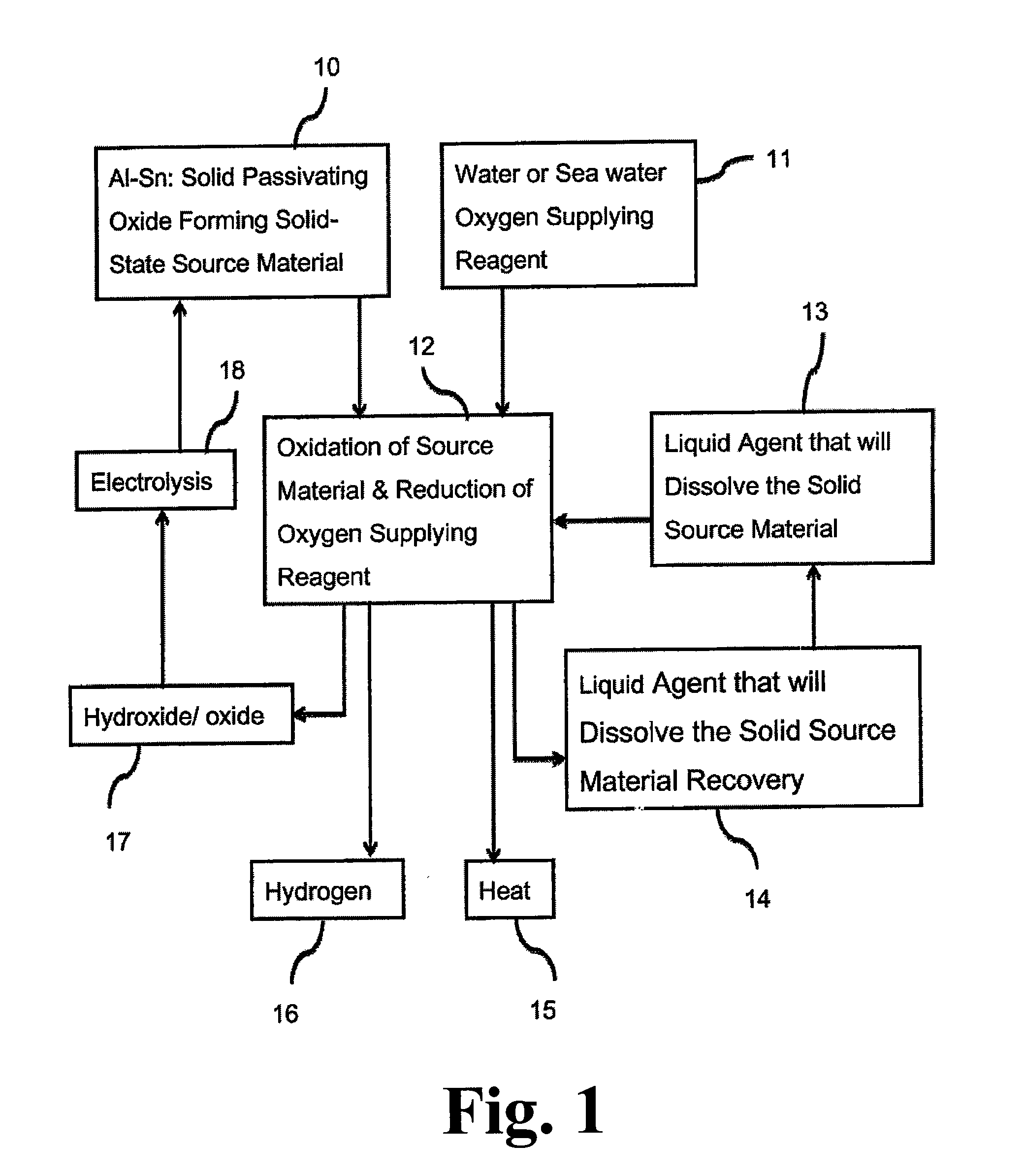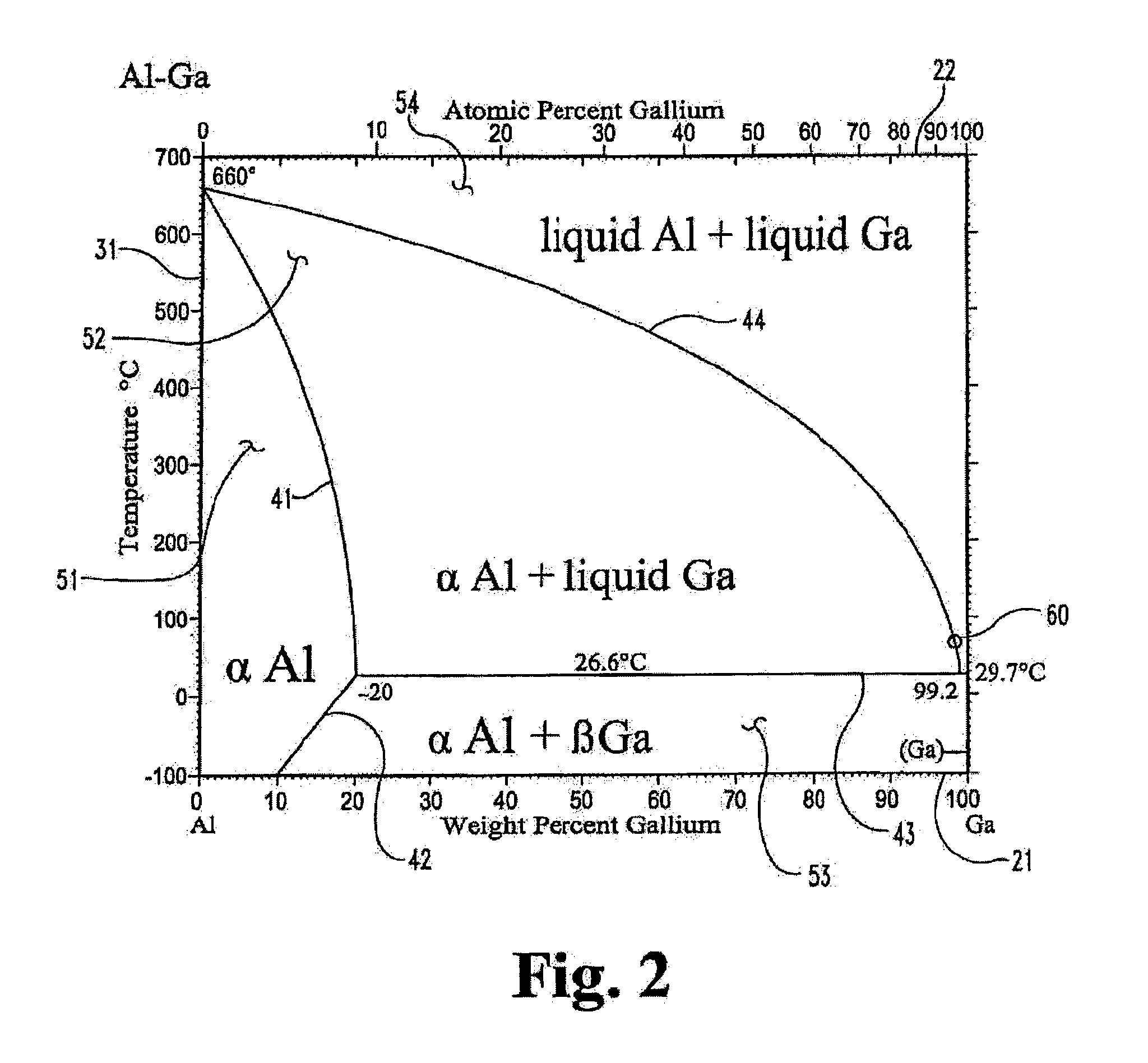Energy storage and generation of hydrogen and heat on demand
a technology of energy storage and hydrogen, applied in the direction of aluminium compounds, chemistry apparatus and processes, other chemical processes, etc., can solve the problems of affecting the wide-spread development and use of the technology, affecting the safety of energy storage, and the inability to meet the needs of small power supply needs. , to achieve the effect of minimal oxidation activity and safe energy storag
- Summary
- Abstract
- Description
- Claims
- Application Information
AI Technical Summary
Benefits of technology
Problems solved by technology
Method used
Image
Examples
example 1
[0081]This example illustrates the fabrication of various alloys (listed in Table 4 below) in accordance with the principles of the present invention.
TABLE 4MetalPurityVendorAluminum99.99%Alfa Aesar #43428Gallium99.99%Recapture MetalsIndium99.999% Alfa Aesar #14720Tin99.99%Atlantic Metals & Alloys
[0082]Fabrication is done by means of melting and splat or cast cooling. Aluminum pallets are placed in an aluminum oxide crucible and then placed in an air free furnace by purging the furnace with continuous nitrogen or argon gas flow to prevent oxidation. The temperature is increased from room temperature to 700° C. Once the temperature reaches 700° C., the aluminum pallets (inside their crucibles) are left inside the furnace for one to two hours to completely melt all the pallets and make one single piece of aluminum. Once all aluminum pallets are melted and become one piece, the furnace is turned off so that the piece can reach room temperature.
example 2
[0090]This example illustrates an Al—Sn alloy fabrication method in accordance with the principles of the present invention.
[0091]In accordance with this illustrative example, fabrication is done by means of melting and splat or cast cooling. Aluminum pallets are placed in an aluminum oxide crucible and then placed in an air free furnace by purging the furnace with continuous nitrogen or argon gas flow to prevent oxidation. The temperature is increased from room temperature to 700° C. Once the temperature reaches 700° C., the aluminum pallets (inside their crucibles) are left inside the furnace for one to two hours to completely melt all the pallets and make one single piece of aluminum. Once all aluminum pallets are melted and become one piece, the furnace is turned off so that the piece can reach room temperature.
[0092]Tin is placed on top of the aluminum in a ratio of 90:10 Al:Sn, and the crucible containing the aluminum and tin alloy is then placed back into the air free furnace...
example 3
[0096]In accordance with another non-limiting and illustrative experiment, a rod-shaped Al rich alloy composed of 98 wt % Al, 2 wt % Sn was prepared. This alloy weighed approximately 5 g. Separately, a liquid alloy composed of 15 g of Ga and 4 g of In was prepared in a 250 ml crystallization dish. The crystallization dish was placed on top of a hotplate that was set at 60° C. The Al rich alloy was then placed on top of the liquid alloy inside the crystallization dish. The Al rich alloy was left to soak for approximately 3 hours. Then room temperature water, measured approximately 19° C., was poured into the crystallization dish. The reaction occurred instantly by generating bubbles on the entire surface of the alloy. After the reaction stopped, it was observed that no original form of the alloy was found. Similar experiments were conducted with the same set-up, but varying the amount of time the Al rich alloy was soaked in the liquid alloy. Insofar, starting from 3 hours down to 45 ...
PUM
| Property | Measurement | Unit |
|---|---|---|
| temperature | aaaaa | aaaaa |
| composition | aaaaa | aaaaa |
| grain boundary | aaaaa | aaaaa |
Abstract
Description
Claims
Application Information
 Login to View More
Login to View More - R&D
- Intellectual Property
- Life Sciences
- Materials
- Tech Scout
- Unparalleled Data Quality
- Higher Quality Content
- 60% Fewer Hallucinations
Browse by: Latest US Patents, China's latest patents, Technical Efficacy Thesaurus, Application Domain, Technology Topic, Popular Technical Reports.
© 2025 PatSnap. All rights reserved.Legal|Privacy policy|Modern Slavery Act Transparency Statement|Sitemap|About US| Contact US: help@patsnap.com



